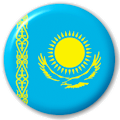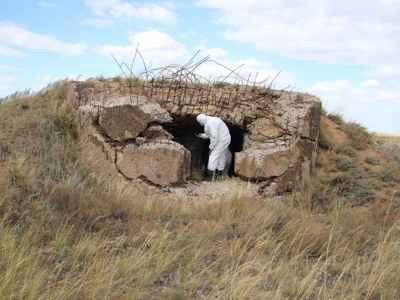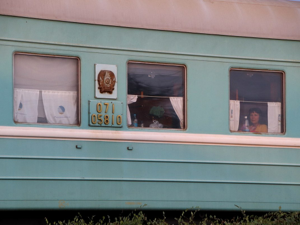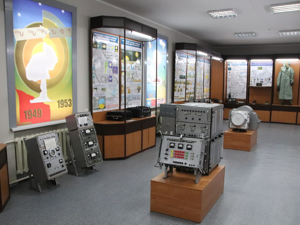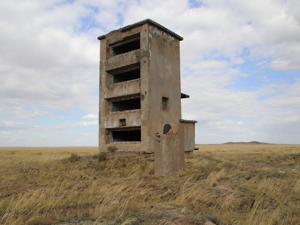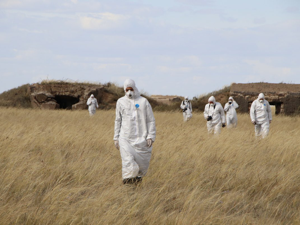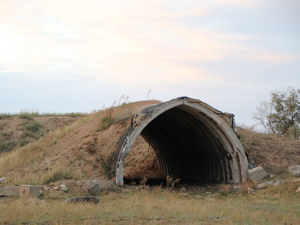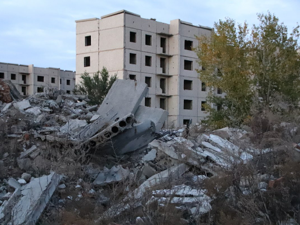Kyrgyzstan and Tajikistan 2018
Kyrgyzstan and Tajikistan 2018

Kazakhstan 2018
Kurchatov is a different world from Astana. Gone are the flashy high-rise buildings, the wide streets, the modern cars, the obvious financial investment. Instead we have decaying Soviet-era buildings, poor roads, old vehicles, indeed something akin to a poorly maintained museum of a remote Soviet settlement – which is really what Kurchatov is in many ways.
We arrived in Kurchatov at 6:45am, and disembarked down the steps from the train carriage onto bare earth – the short, concrete ground-level railway platform in this town ended a long way away from the carriage we were in. We packed ourselves and our luggage into a tiny bus that trundled its way to our hotel, the Mayak Hotel, a stunning example of a dimly lit, grey polished concrete, angular Soviet hotel from the 1960s that was originally built to accommodate the scientists involved in the USSR’s nuclear testing program. I can’t say it hasn’t been renovated though; the old wooden floors in my room have recently been revarnished, and the room is filled with the overpoweringly strong fumes from the varnish. We are, of course, the only guests in this hotel, which is still run by the Kazakh Institute of Atomic Energy.
Indeed, many things in this declining town are run by (or for) the Kazakh Institute of Atomic Energy, including the bus we have been using here. It is a small bus, barely able to fit our group, and yet it is the biggest bus in the town. This reflects the town’s origins. Kurchatov was founded in 1947 for the single purpose of making Stalin’s dream of Soviet nuclear weapons into a reality. Under the control of the KGB Chief Lavrentiy Beria and scientist Igor Kurchatov, this is where the arms race became a two-horse event.
After checking into our hotel, we had time for a quick shower and breakfast before heading off at 9:00am to inspect the Museum of the Semipalatinsk Test Site. I sometimes inwardly groan at the prospect of visiting a museum developed during the Soviet era in an old Russian style building, but this museum was fabulous. Despite the fact that all the labels in the displays were only in Kazakh and/or Russian, the enthusiastic museum curator provided an excellent, informative insight into the history and processes of Soviet atomic weapons testing, all of which was done in the area immediately south of Kurchatov known officially as the Semipalatinsk Test Site, but more commonly by its unofficial name, The Polygon. This was no small enterprise – the area of The Polygon is a little larger than Belgium, and although it is still a restricted zone for which special permission is required for entry, it is the only former nuclear testing site in the world that it is possible for the public to visit. The Kazakhs win the international prize for openness and transparency in this ‘competition’.
The museum’s exhibition included maps, photographs, statistics, dioramas, posters, original equipment used in the testing (including the machine used to trigger the tests), and even a virtual reality display of the various places in The Polygon where bombs were tested, whether atmospherically, on the surface or underground.
Having obtained an excellent introduction to the Soviet nuclear testing program, we once again squeezed into the Institute’s small bus and drove 65 kilometres to the south-west, deep the formerly off-limits (very off limits!) Semipalatinsk Polygon. The area was chosen for remoteness, sparse population density (i.e. unpopulated), and flat terrain, although the terrain seemed anything but flat as the bus bounced wildly along the unsealed road.
Our destination was Ground Zero, the nuclear epicentre where the first Soviet atomic bomb was tested in 1949. On the way to Ground Zero, we stopped at several places such as markers, and bunkers and towers that had been increasingly destroyed by the blast as we neared the epicentre. At one of the stops on the way to Ground Zero, we all donned special white hooded overalls, shoe covers and gloves to protect us from the radiation contamination of the environment, and especially radioactive dust, although these days, the dangerous zone is confined to a radius of only about 50 metres around Ground Zero.
The actual point of Ground Zero from the 1949 blast is marked by a small lake, just a few metres deep, surrounded by lush reed growth. The lake formed when the bomb exploded 30 metres above ground level and the blast compressed the land beneath it. Nearby there are the remains of thick reinforced concrete bunkers that were completely or partially destroyed in the blast, and further away, radiating outwards from the epicentre are multi-level towers that had contained instruments to measure the effect of the blast at various distances from the explosion.
It was 4:00pm by the time we returned to Kurchatov, much of the time having been spent putting and later taking off the protective gear, and of course the drive (the 65 kilometres to and then from the epicentre took an hour and a half of driving time each way). Together with many other people with whom I was travelling, I thought 4:00pm was a bit late to break for lunch, and I would have preferred to use the remaining daylight for our remaining visit of the day. Nonetheless, lunch had been arranged, so we spent from 4:00pm until 5:00pm having lunch, before setting off in two minivans for a one-hour drive to our last destination for the day, Chagan.
From 1954 to 1994, Chagan was a deeply secret long-range bomber base. With the breakup of the Soviet Union, Kazakhstan agreed to give its nuclear bomber force to Russia and the base was abandoned. We arrived at Chagan just before sunset, and began our visit by walking through the building that used to be the operational command post. It is now just a sad relic of its glory days, with collapsing walls and floors, corridors filled with rubble, and merely a winged red star on the front façade giving some clue to its former role.
As darkness descended, we drove past the four kilometre long runway to an area of abandoned hangers, mostly small ones that had been used for cars and equipment rather than strategic bombers. With darkness well and truly upon us, we drove a few kilometres to the now abandoned garrison town which accommodated the base staff from 1954 to 1994. Once boasting a population of about 10,000 people, the high-rise blocks of flats now stand completely stripped like the setting of a post-apocalyptic movie.
We began our drive back to Kurchatov about an hour after sunset, and we reached the town at a little after 8:45pm. Only five people wanted dinner by that late stage, so we were all taken to a small store to buy alternative food if we wanted, and those of who didn’t want dinner in the restaurant were brought back to our hotel at a little after 9:00pm.
It was thus a long day, especially considering the poor sleep we had on the overnight train journey last night, but a fascinating one that provided great insights into one of the world’s truly historically significant places.

Day 11
Kurchatov and The Polygon
Saturday
22 September 2018
